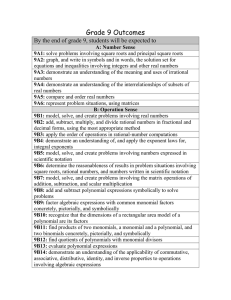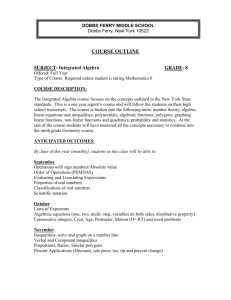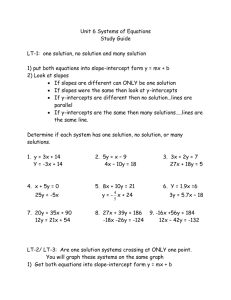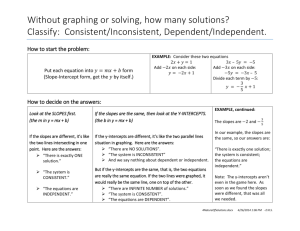Math 9 Course Outline 2012
advertisement
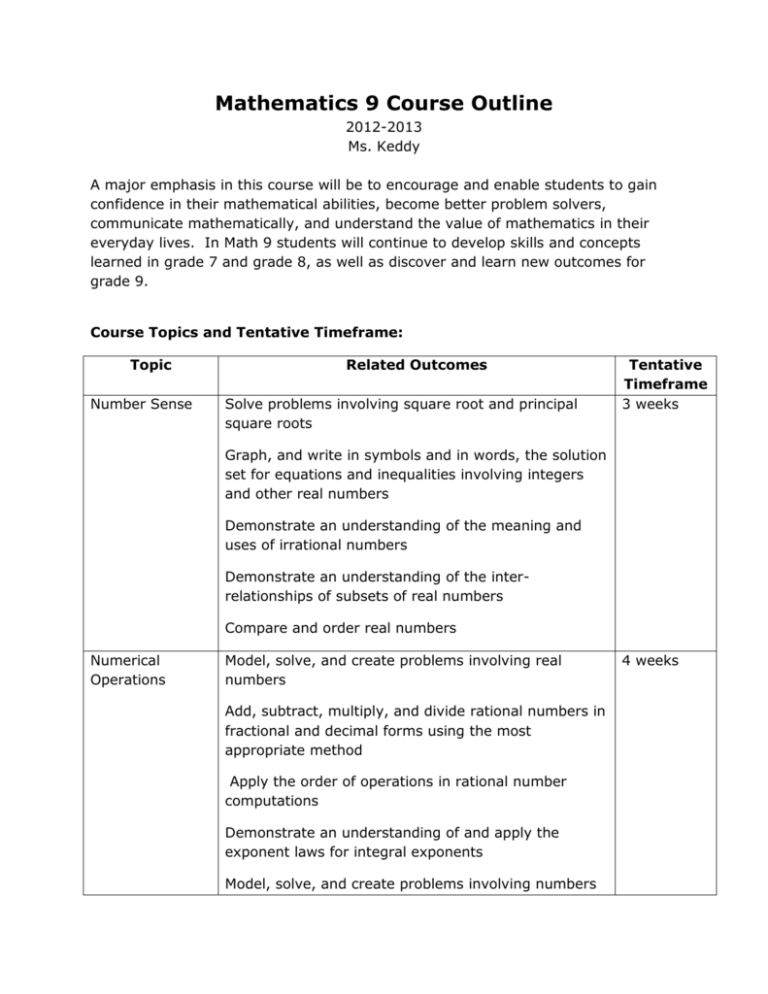
Mathematics 9 Course Outline 2012-2013 Ms. Keddy A major emphasis in this course will be to encourage and enable students to gain confidence in their mathematical abilities, become better problem solvers, communicate mathematically, and understand the value of mathematics in their everyday lives. In Math 9 students will continue to develop skills and concepts learned in grade 7 and grade 8, as well as discover and learn new outcomes for grade 9. Course Topics and Tentative Timeframe: Topic Number Sense Related Outcomes Solve problems involving square root and principal square roots Tentative Timeframe 3 weeks Graph, and write in symbols and in words, the solution set for equations and inequalities involving integers and other real numbers Demonstrate an understanding of the meaning and uses of irrational numbers Demonstrate an understanding of the interrelationships of subsets of real numbers Compare and order real numbers Numerical Operations Model, solve, and create problems involving real numbers Add, subtract, multiply, and divide rational numbers in fractional and decimal forms using the most appropriate method Apply the order of operations in rational number computations Demonstrate an understanding of and apply the exponent laws for integral exponents Model, solve, and create problems involving numbers 4 weeks expressed in scientific notation Determine the reasonableness of results in problem situations involving square roots, rational numbers, and numbers written in scientific notation Select and use appropriate strategies in problem situations Algebraic Operations Add and subtract polynomial expressions symbolically to solve problems 4 weeks Factor algebraic expressions with common monomial factors concretely, pictorially, and symbolically Recognize that the dimensions of a rectangular area model of a polynomial are its factors Find products of two monomials, a monomial and a polynomial, and two binomials Concretely, pictorially, and symbolically Find quotients of polynomials with monomial divisors Evaluate polynomial expressions Solving Equations Demonstrate an understanding of the applicability of commutative, associative, distributive, identity, and inverse properties to operations involving algebraic expressions Solve single-variable equations algebraically and verify the solution 4 weeks Solve first-degree single-variable inequalities algebraically, verify the solutions, and display them on number lines Solve and create problems involving linear equations and inequalities Geometry I Interpret, represent, and apply mapping notation for transformations on the coordinate plane. Make and apply informal deductions about the minimum sufficient conditions to guarantee a 3 weeks translation, reflection, and a 180 rotation. Make and apply information deductions about the minimum sufficient conditions to guarantee the similarity of two triangles. Relations Represent patterns and relationships in a variety of formats and use these representations to predict and justify unknown values 4 weeks Interpret graphs that represent linear and non-linear data Construct and analyse tables and graphs to describe how changes in one quantity affect a related quantity Determine the equations of lines by obtaining their slopes and y-intercepts from graphs, and sketch graphs of equations using y-intercepts and slopes Solve indirect measurement problems by connecting rates and slopes Matrices Represent problem situations using matrices 1 week Model, solve, and create problems involving the matrix operations of addition, subtraction, and scalar multiplication Volume and Surface Area Relate the volumes of pyramids and cones to the volumes of corresponding prisms and cylinders Estimate, measure, and calculate dimensions, volumes, and surface areas of pyramids, cones, and spheres in problem situations Solve problems involving square root and principal square root 4 weeks Geometry II Make and apply generalizations about the properties of 3 weeks Platonic Solids. Solve problems using 3-D shapes using visualization, reasoning, and geometric modeling. Recognize, name, describe, and represent arcs, chords, tangents, central angles, inscribed angles and circumscribed angles, and make generalizations about their relationships in circles Scatterplots Describe characteristics of possible relationships shown in scatterplots 2 weeks Sketch lines of best fit and determine their equations Sketch curves of best fit for relationships that appear to be non-linear Data Analysis Select, defend, and use the most appropriate methods for displaying data 1 week Draw inferences and make predictions based on data analysis and data displays Demonstrate an understanding of the role of data management in society Probability Make predictions of probabilities involving dependent and independent events by designing and conducting experiments and simulations Determine theoretical probabilities of dependent and independent events Demonstrate an understanding of how experimental and theoretical probabilities are related Recognize and explain why decisions based on probabilities may be combinations of theoretical calculations, experimental results, and subjective judgments 2 weeks Required Materials: Students are expected to come to each class prepared with: π π π π π π binder looseleaf pencils and erasers math set scientific calculator graph paper Evaluation: Observation/Discussion Journal Assignments/Projects Quizzes Tests January Midterm 10% 10% 30% 10% 30% 10% 85% of final grade June Final Exam 15% 15% of final grade General Information π All math work must be completed in PENCIL. Work done in pen will NOT be accepted. π Practice questions will be assigned on a regular basis. While these questions will not always be collected and marked, the completion of these questions is essential to the development of concepts taught in this course and must be completed. Additional questions will often be provided for students who need/wish to have more practice to solidify concepts and ensure understanding. π If you miss a class it is very important that you find out what was covered that day. Please see me beforehand if you know you will be absent the day of a quiz or test. Assignments are due on the assigned day at the beginning of class. π Homework, announcements, a class calendar, and course documents can all be accessed via a classroom website. This will be updated on a daily basis. Please feel free to access this site to remain up-to-date with class activities. To get to the site, go to the ICS website http://sharepoint.tcrsb.ca/ics/default.aspx and click on Classroom Links. Extra Help! π Extra help sessions are available at the following times: Mornings: 8:15 – 8:45 on Day 1 and Day 2 in the MPR Afternoon: 3:15 – 3:45 on Day 1 in the MPR Lunch: 12:15 – 12:40 on Day 2 in the classroom Please feel free to contact me with questions or concerns at any time. School: 839-6300 Email: juliekeddy@staff.ednet.ns.ca Student Signature: ___________________________ Parent/Guardian Signature: ____________________________
